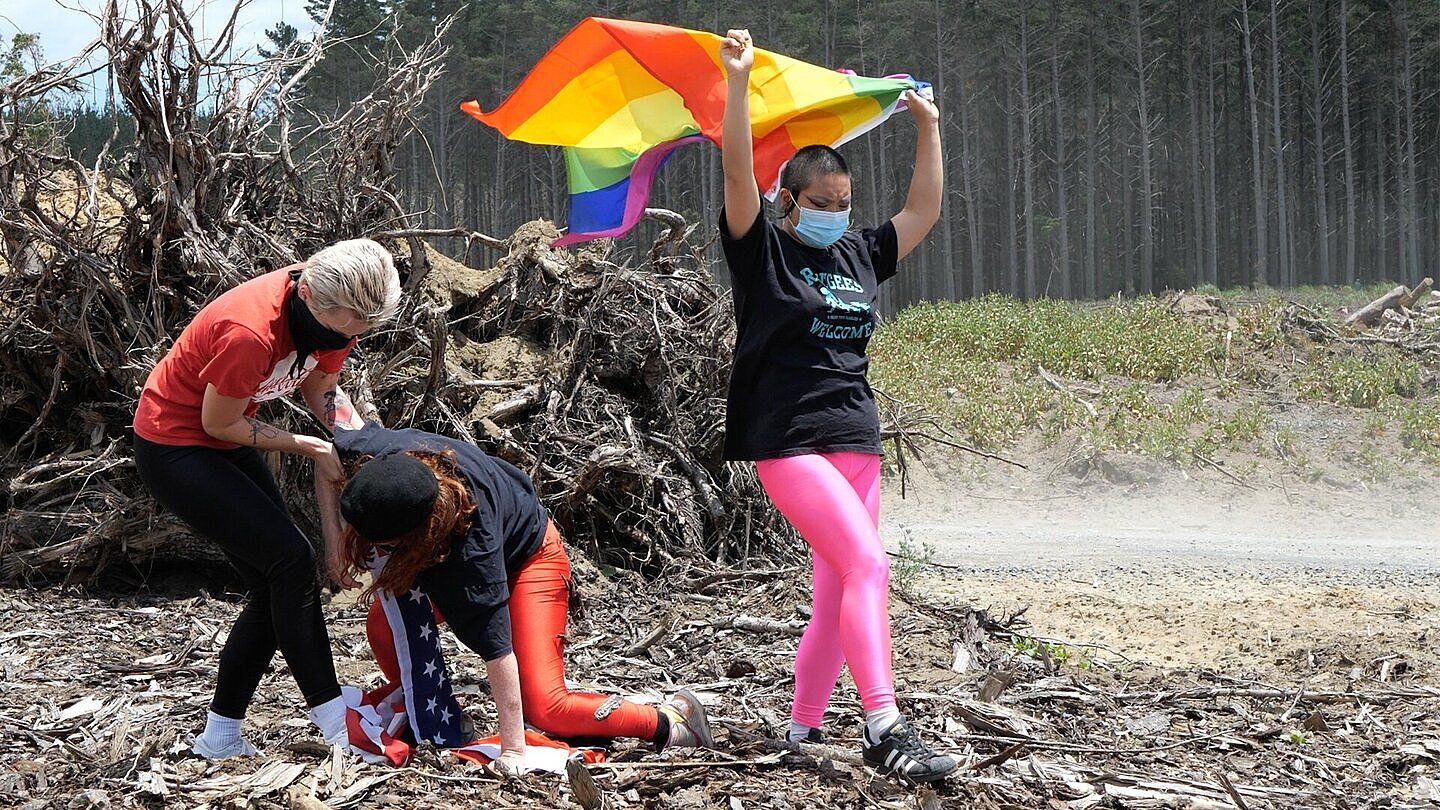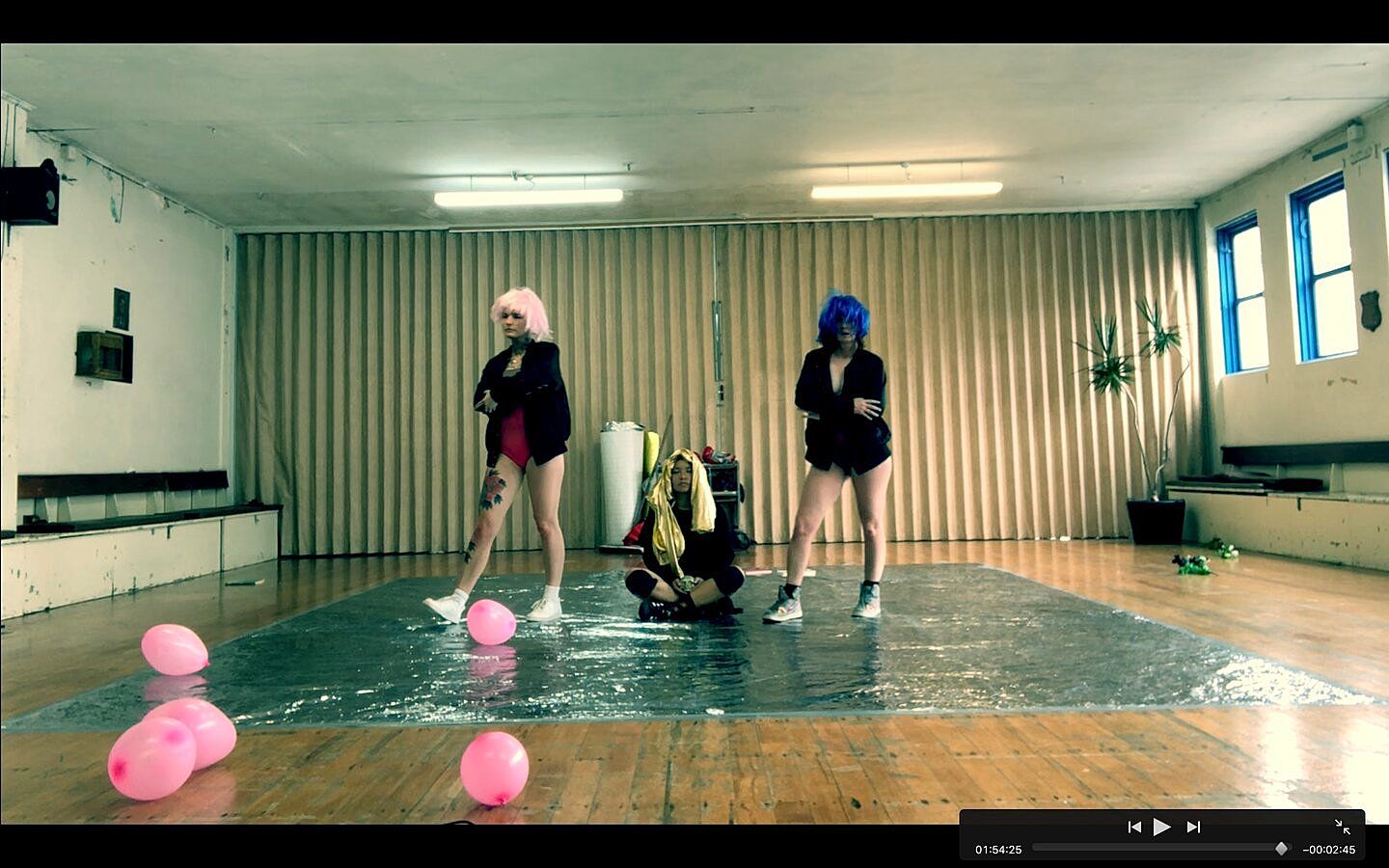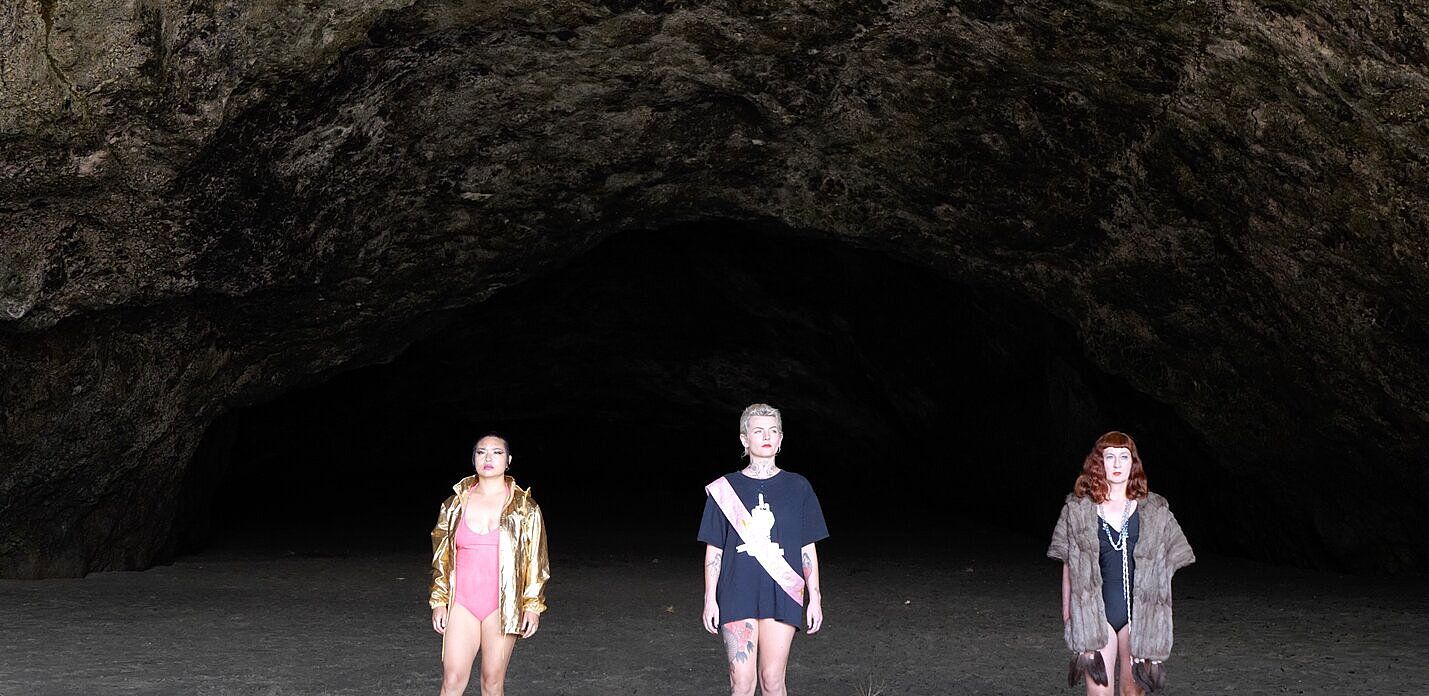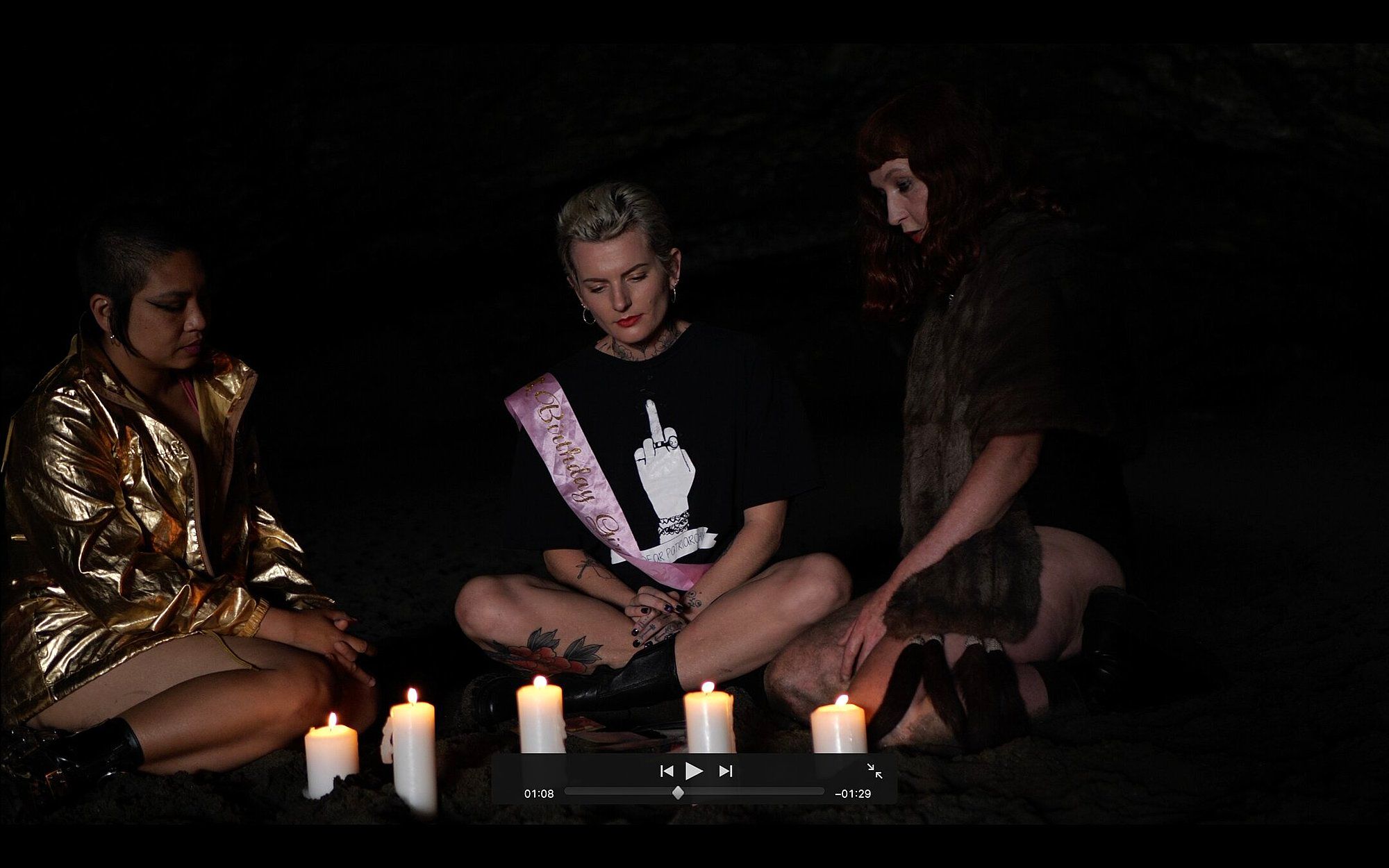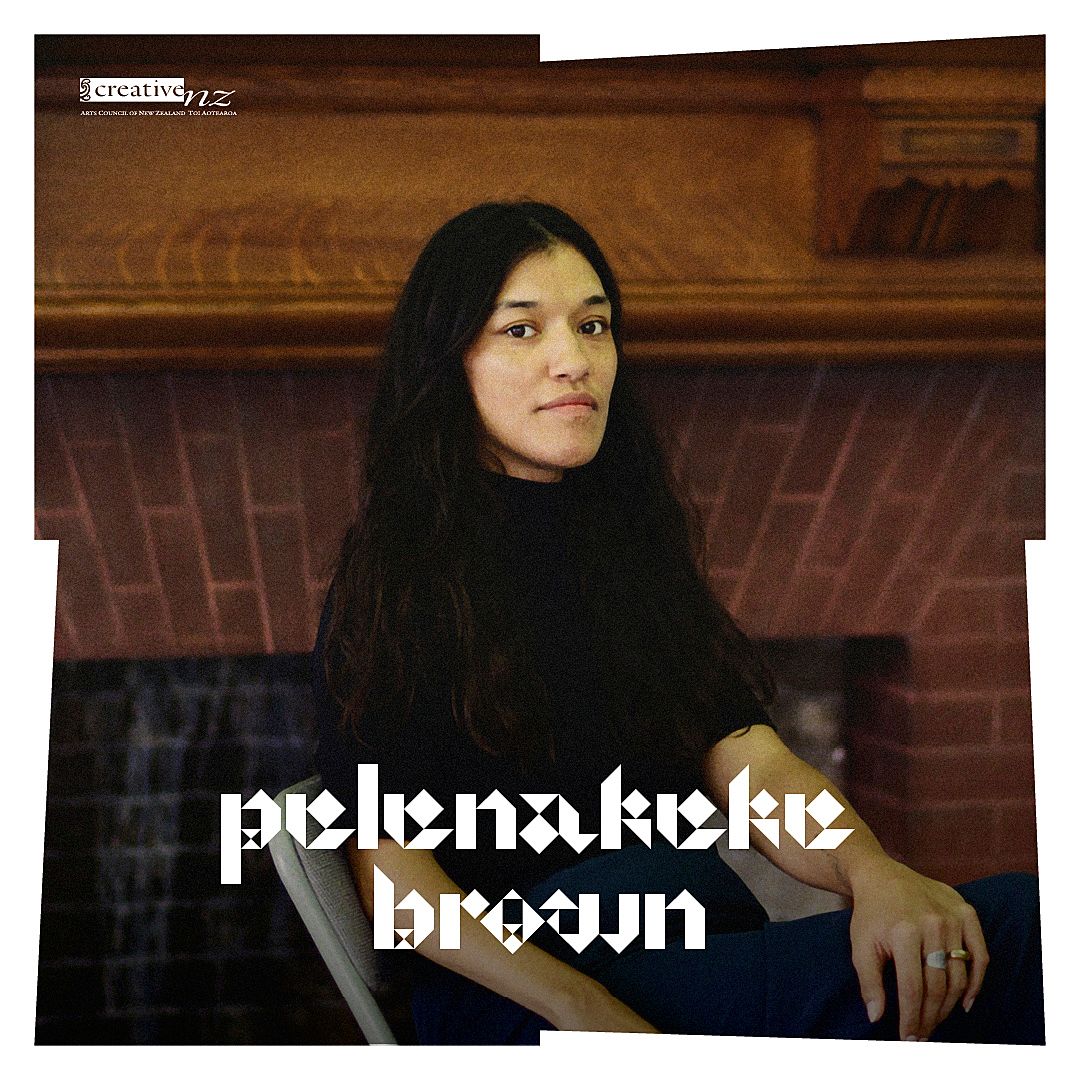All You Can Eat: A Review of Rituals of Destruction
Pelenakeke Brown feasts on Alexa Wilson’s Rituals of Destruction and, like any discerning food critic, makes recommendations for your future dining.
Alexa Wilson's Rituals of Destruction is a smorgasbord of content, an array of videos presented within a menu of entrées, mains, desserts, and even vegan and gluten-free options. The audience is asked to choose from the menu, emailing Alexa with their selections and a koha. I decided to delve into the ‘all you can eat’ option for $20 to get the best opportunity to ‘taste’ what Alexa is offering.
Rituals of Destruction is framed as a “salvaging of live performance, which is dissolved, remixed, interrupted, butchered, transformed, and non-chronological.” I could feel this, with some segments working more successfully than others. The team was impacted by Covid-19, with some footage filmed on an iPhone due to a team member having to isolate before the final run. This work does feel like the ultimate pivot, trying to contort and deliver no matter the medium or obstacle, that even a global pandemic can’t stop. The show must go on, or, as one artist says in one of the segments, “the artist is on a timeline.”
As you would at any fine-dining restaurant, I spent a lot of time on the menu, trying to choose complementary dishes with a side of oooh what is that? Except, unlike in a restaurant, I ended up being my own server, writing down each choice so as not to get mixed up.
My fine-dining experience began in the morning, when I sat down and blew my nose to play that fun game of are these Covid symptoms or just morning gunk?
I spent a lot of time on the menu, trying to choose complementary dishes with a side of oooh what is that?
I begin with ‘2. Welcome and Visualisation, a spoken meditation on Climate Change.’ I thought a soothing meditation would be a great way to start the day. Instead, I watch three figures slowly undress while early-2000s banger ‘Booty Wurk’ by T-Pain plays. I bop along. Maybe this is how meditations should be. At least I am noticing my body. Things get a bit more hectic, with the meditation leading me to “imagine you are in a rip or in a Wellington wind.” I'm ok with that because I’m still really enjoying T-Pain. The meditation ends with the video cutting us off – reminiscent of an abrupt Zoom webinar ending.
I move on to a second entrée:‘4. Dance off to Dubstep’, where they really do just dance-off to dubstep on a tennis court. But dance in that Dance way of somatic movement – doing strange, beautiful, silly gestures. As they dance, you can see kids sitting at the perimeter watching through the fence. I wonder what they’re thinking. Alexa makes the tennis net her dance partner, with my favourite shot being the view through it as they move. “Just the kind of thing my dancey heart loves,” I scribble down in my notes.
I watch three figures slowly undress while early-2000s banger ‘Booty Wurk’ by T-Pain plays. I bop along. Maybe this is how meditations should be
I’m finally ready for my main course (at 11am). I’ve chosen ‘8. Video Interlude – Tarot reading for Pisces.’Even though I’m not a Pisces (Libra for Life lol), it is Pisces season, so I wanted to honour their qualities and indulge in some tarot. It’s a harsh reading if you are a Pisces, with some home truths delivered, such as apparently you all love to manipulate. The aloof nature of the tarot reader makes me wonder if they're an Aquarius.
I’ve chosen a second main (all you can eat, remember), ‘11. Portraits / Bums / Clump original (go together, package)’, but I find this segment a struggle after watching the off-putting tarot reading. Three dancers move towards us in a forest, accompanied by high-pitched operatic music. Their location switches suddenly to in front of an industrial warehouse. As they get closer, each person takes a turn on the mic, invoking political theory, Black Lives Matter and people who have died at the hands of police, while the screen tells us it is a different diversity day such as ‘this is non-English day’ and ‘This is Pride Week’. This work is difficult to digest and I end up taking a short break from my dining experience.
I return and watch ‘12. Art Games (Improv)’.We are back in the studio and seeing some rehearsal examples and, really, the creative process, which is rooted in improvisation. It reminds me of the messy part of making art and what it is like to be in the studio together. How silly it can be, and how much fun. The privilege of being an artist and getting to do weird, amazing things together.
Alana Yee, Shani Dickins and Alexa Wilson in Rituals of Destruction. Film credit: Veronica Manchego
Each performer takes a turn to observe the others and make cultural commentary. One performer (the only visible person of colour) asks a white performer, “How are you decolonising?” Everyone in the room laughs, which I think is often our response to these kinds of questions. But this is when I become the most engaged. I do want to know how you are being an ally.
This work obviously wants to grapple with climate change and social justice, and the shit-show of a world that we live in. The themes referenced throughout are heavy, but they often feel removed and glib. Art for art’s sake, or outrage for art’s sake. But the question – “How are you decolonising?” – asked seemingly off the cuff, catches the interviewee unaware. It feels like we finally have a connection to these issues, and the artists can start to delve into this difficult terrain, beginning with their own context. This question alone is much more powerful than the uttering of “Black Lives Matter”, in the earlier segment. Why? Because I think by interrogating our own positionality and our relationship with these issues we can get into the messy, uncomfortable murkiness of what these issues mean and progress them from there. And that messiness I think Alexa does wish to explore.
This work obviously wants to grapple with climate change and social justice, and the shit-show of a world that we live in
Art is often about ideas, our relationships with these ideas and each other. But if we can’t interrogate our context, our anti-Blackness in Aotearoa, or how we can be tangata tiriti, it feels trite to leap first to the global context of Black Lives Matter. Or maybe I am just too sensitive, after living in the States and seeing that pain, to then watch another group use this pain to indicate a political art message. The work feels rooted in political resistance, but I would have appreciated first interrogating our own political situations before leaping to a global context.
I move to dessert: ‘13. Slow motion protest’. It feels like a palate cleanser, the sounds of the running water and wind with just the bodies and their flags in action. But, again, I would have appreciated understanding their connection to these flags.
I’m not having a second breakfast, but I have a second dessert: ‘17. AI Priestess Chair dance / Motivational talk on Failure/Success’. I’ve been wallowing in feelings of failure since the pandemic, so I would love us to talk about it more. It’s probably the work I’ve been looking forward to the most. Alexa dances alone with a chair as a love ballad plays. Text appears on the screen that meditates on success and failure, and that the two are connected – either side of a coin. I realise that a lot of the works are preoccupied with labels or categories, and this work tries to address that. I want more of this work. Let’s talk more about failure, everybody.
It feels like a palate cleanser, the sounds of the running water and wind with just the bodies and their flags in action
Film credit: Veronica Manchego
I decide to try one of the two vegan offerings at the last minute: ‘21. Video Interlude – Lipstick earthquake’. I know it’s out of order, but I am so glad I did it. This is my favourite offering on the menu and even though it’s a video from the internet it makes complete sense as to why Alexa includes it. It’s ridiculously funny, but also somehow sums up the state of the world.
Rituals of Destruction plays with rituals and destruction and, in doing so, offers us snapshots into the team’s creative process. Art often documents where you are as an artist, and the ideas and questions that are preoccupying you at that time. This menu of documentation feels like fragments or morsels of ideas – processes. What connects me the most is witnessing the making process and, more importantly, the ideas and questions that the performers are trying to explore.
Film credit: Veronica Manchego
Words, language and naming are used throughout Rituals of Destruction to reference political ideas, positionality and ways to resist. In the tarot reading in ‘11. Portraits / Bums / Clump original (go together, package)’ the ‘character’ talks about manipulation, with “apparently Pisces please stop manipulating”, and then, “You’re trying to turn the river the other way – and it’s just not really possible. I’m getting the image of you’re trying to get all these dwarfs involved to help move the river the other way – which sounds like an exploitative 80s film.” I know it was meant to be a throwaway, funny remark, but it was difficult and off-putting to hear, on multiple levels. Firstly, calling Little People 'dwarfs’ can be inappropriate (some people consider it derogatory). In this context the speaker has stereotyped this community as a group that is easily exploited, and infantilises them and their bodies while using them as the butt of a careless remark.
Rituals of Destruction is playing for the rest of the month, and I encourage you to pick as you please, watch and then think through the ideas
When we use disabled people as an example of inferiority, something to laugh at, or in a negative context, this is an example of ableist language. No matter if it is unintentional. When you start to understand you will hear how often in our everyday lives we use words related to disability and disabled people that are immediately negative, such as, “I was crippled.” You might have been anxious or unable to move, but you weren’t crippled. Or everyone’s casual favourite, “that was lame.” Again, no. You’re using this word to depict a negative experience or situation when in fact “that was terrible” might suffice.
As with any dining experience, there are real highs and some dishes that don’t quite sit right with me. But I want to applaud the team for making something and trying to offer it in a manner that is different to engage the viewer. Rituals of Destruction is playing for the rest of the month, and I encourage you to pick as you please, watch and then think through the ideas of decolonisation, success and failure, or just the banal ‘everybody is really into installation art at the moment’. I also encourage you to notice what you are saying, what your words mean, and in what context you use them.
I appreciate all the artists and the work that they have put into this three-course meal with additional options. And, like all dining experiences, I’m shocked when I see the cost of it all – in this case, perhaps more emotionally.
